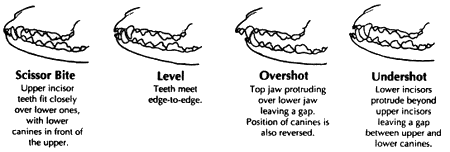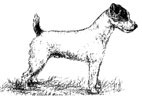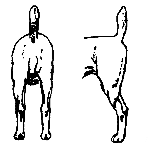JRTCA Breed Standard
The JRTCA has a broad breed standard that is so necessary to preserve this unspoiled type, or strain, of working terrier known as the Jack Russell Terrier.

Everything about the Jack Russell has fox hunting in mind... coloring, conformation, character, and intelligence.
Everything about the Jack Russell has fox hunting in mind... coloring, conformation, character, and intelligence. The body is compact, of totally balanced proportions, the shoulders clean, the legs straight, and most importantly, a small chest (easily spannable by average size hands at the widest part behind the shoulders). The Jack Russell must also be totally flexible, allowing him to maneuver underground. This conformation allows the terrier to follow his quarry down narrow earths. The fox is a good model for the Jack Russell-where the fox can go, so must the terrier.
JRTCA Breed Standard
Characteristics

The terrier must present a lively, active and alert appearance. It should impress with its fearless and happy disposition. It should be remembered that the Jack Russell is a working terrier and should retain these instincts. Nervousness, cowardice or over-aggressiveness should be discouraged and it should always appear confident.
General Appearance
A sturdy, tough terrier, very much on its toes all the time, measuring between 10" and 15" at the withers. The body length must be in proportion to the height, and it should present a compact, balanced image, always being in solid, hard condition.
Head

Should be well balanced and in proportion to the body. The skull should be flat, of moderate width at the ears, narrowing to the eyes. There should be a defined stop but not overpronounced. The length of the muzzle from the nose to the stop should be slightly shorter than the distance from the stop to the occiput. The nose should be black. The jaw should be powerful and well boned with strongly muscled cheeks.
Eyes
Should be almond shaped, dark in color and full of life and intelligence.
Ears
Small "V" shaped drop ears carried forward close to the head and of moderate thickness.

Mouth
Strong teeth with the top slightly overlapping the lower. The left two bites are acceptable; the far left bite (scissor) is preferred.
Neck

Clean and muscular, of good length, gradually widening at the shoulders.
Forequarters
The shoulders should be sloping and well laid back, fine at points and clearly cut at the withers. Forelegs should be strong and straight boned with joints in correct alignment. Elbows hanging perpendicular to the body and working free of the sides.
Body
The chest should be shallow, narrow and the front legs not too widely apart, giving an athletic, rather than heavily chested appearance. As a guide only, the chest should be small enough to be easily spanned behind the shoulders, by average sized hands, when the terrier is in a fit, working condition. The back should be strong, straight and, in comparison to the height of the terrier, give a balanced image. The loin should be slightly arched.

Hindquarters
Should be strong and muscular, well put together with good angulation and bend of stifle, giving plenty of drive and propulsion. Looking from behind, the hocks must be straight.
Feet
Round, hard padded, wide, of cat-like appearance, neither turning in nor out.
Tail
Should be set rather high, carried gaily and in proportion to body length, usually about four inches long, providing a good hand-hold.
Coat

Smooth, without being so sparse as not to provide a certain amount of protection from the elements and undergrowth. Rough or broken coated, without being woolly.
Color
White should predominate (i.e., must be more than 51% white) with tan, black, or brown markings. Brindle markings are unacceptable.
Gait
Movement should be free, lively, well coordinated with straight action in front and behind.
Special Notes
Old scars or injuries, the result of work or accident, should not be allowed to prejudice a terrier's chance in the show ring unless they interfere with its movement or with its utility for work or stud. A Jack Russell Terrier should not show any strong characteristics of another breed.
Faults
Shyness, Disinterest, Overly aggressive, Defects in bite, Weak jaws, Fleshy ears, Down at the shoulder, Barrel ribs, Out at elbow, Narrow hips, Straight stifles, Weak feet, Sluggish or unsound movement, Dishing, Plaiting, Toeing, Silky or woolly coats, Too much color (less than 51% white), Shrill or weak voice, Lack of muscle or skin tone, Lack of stamina or lung reserve, Evidence of foreign blood